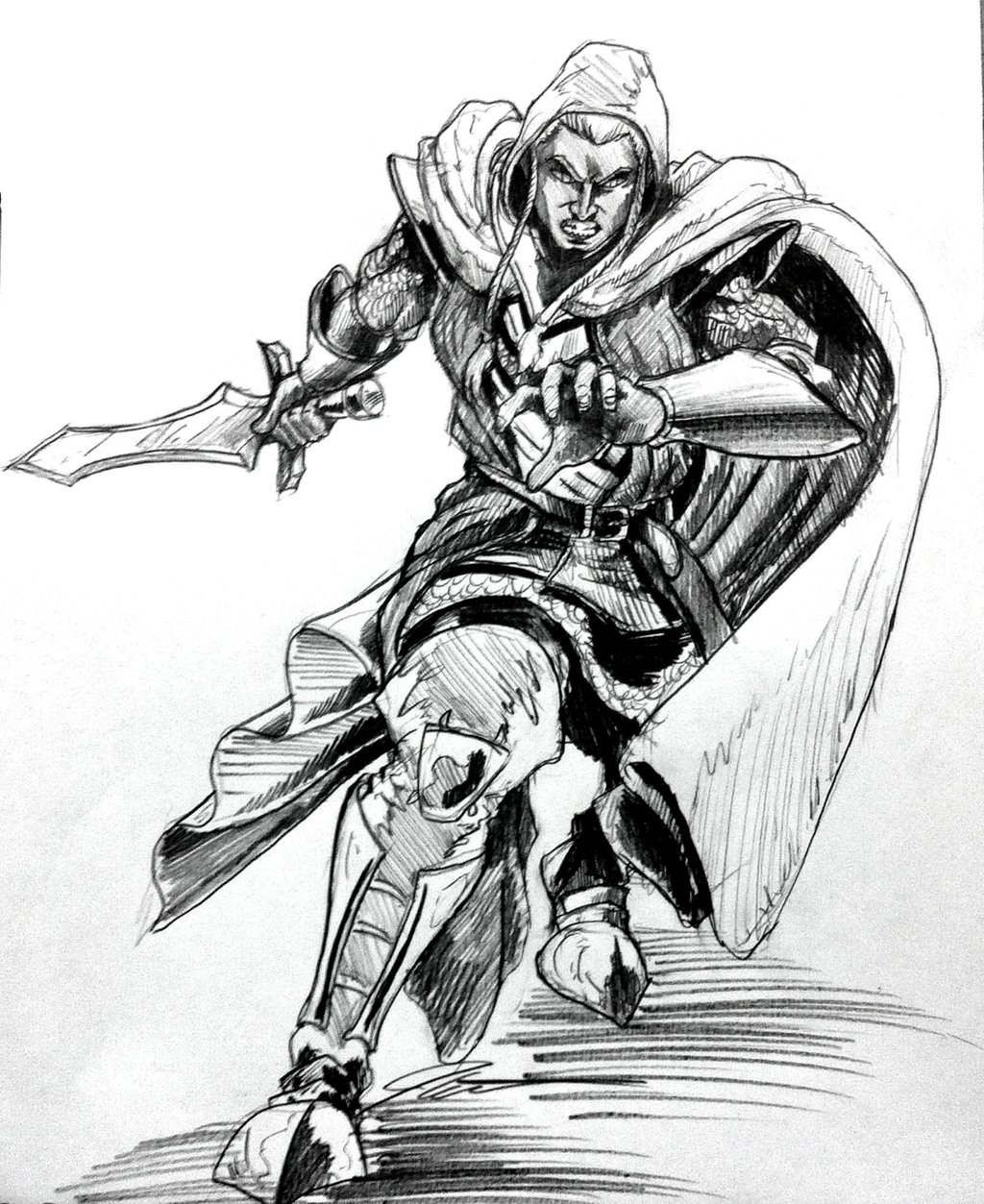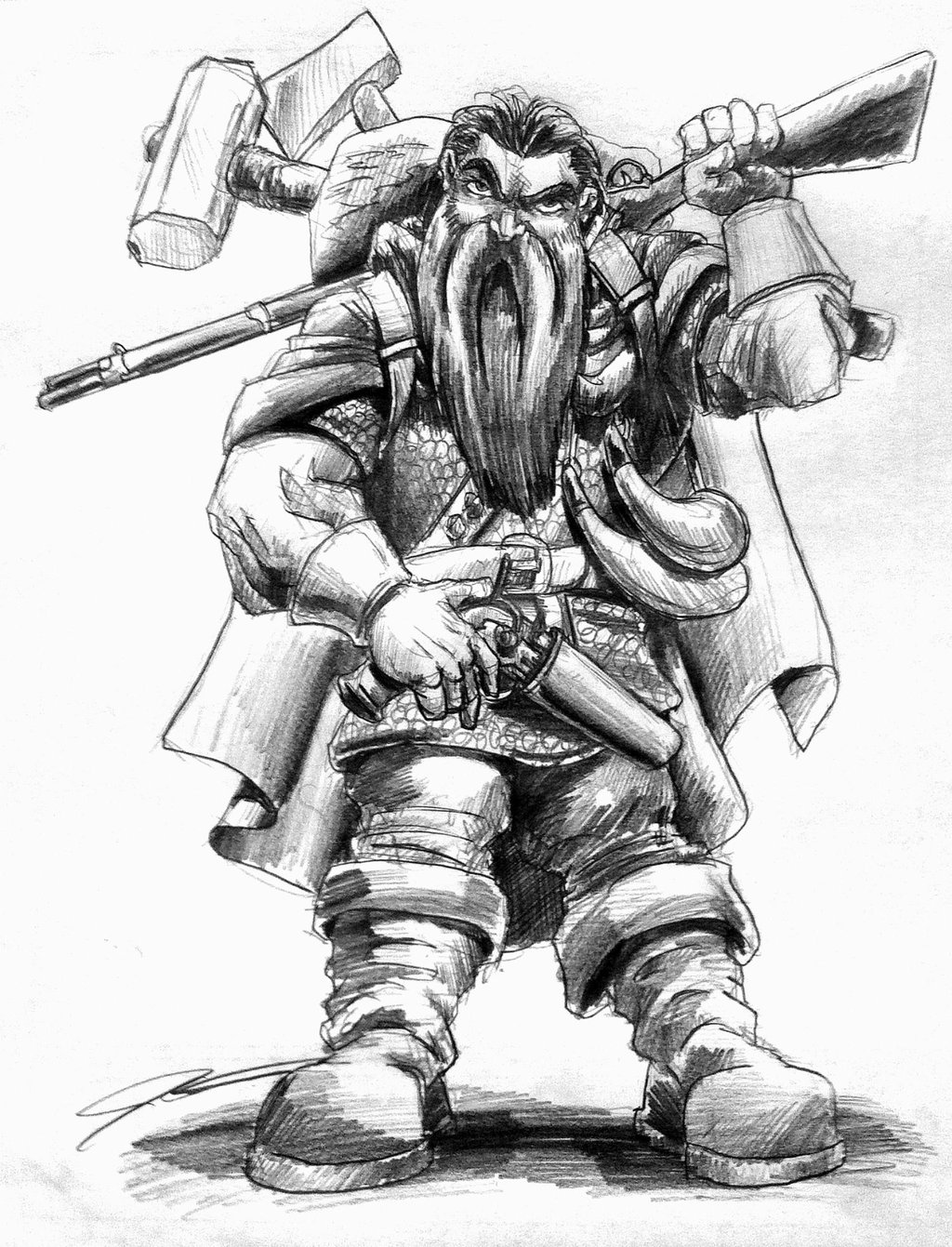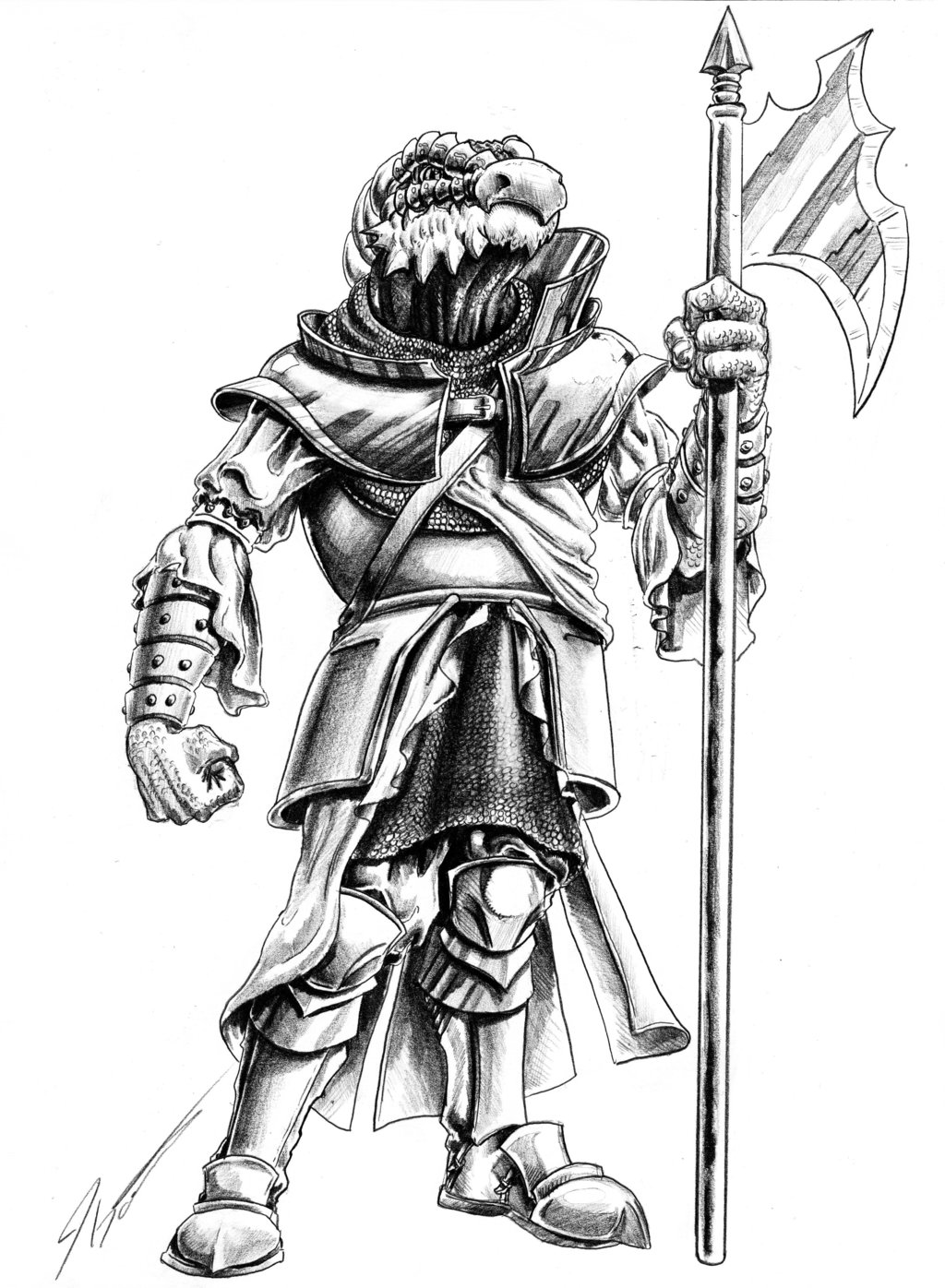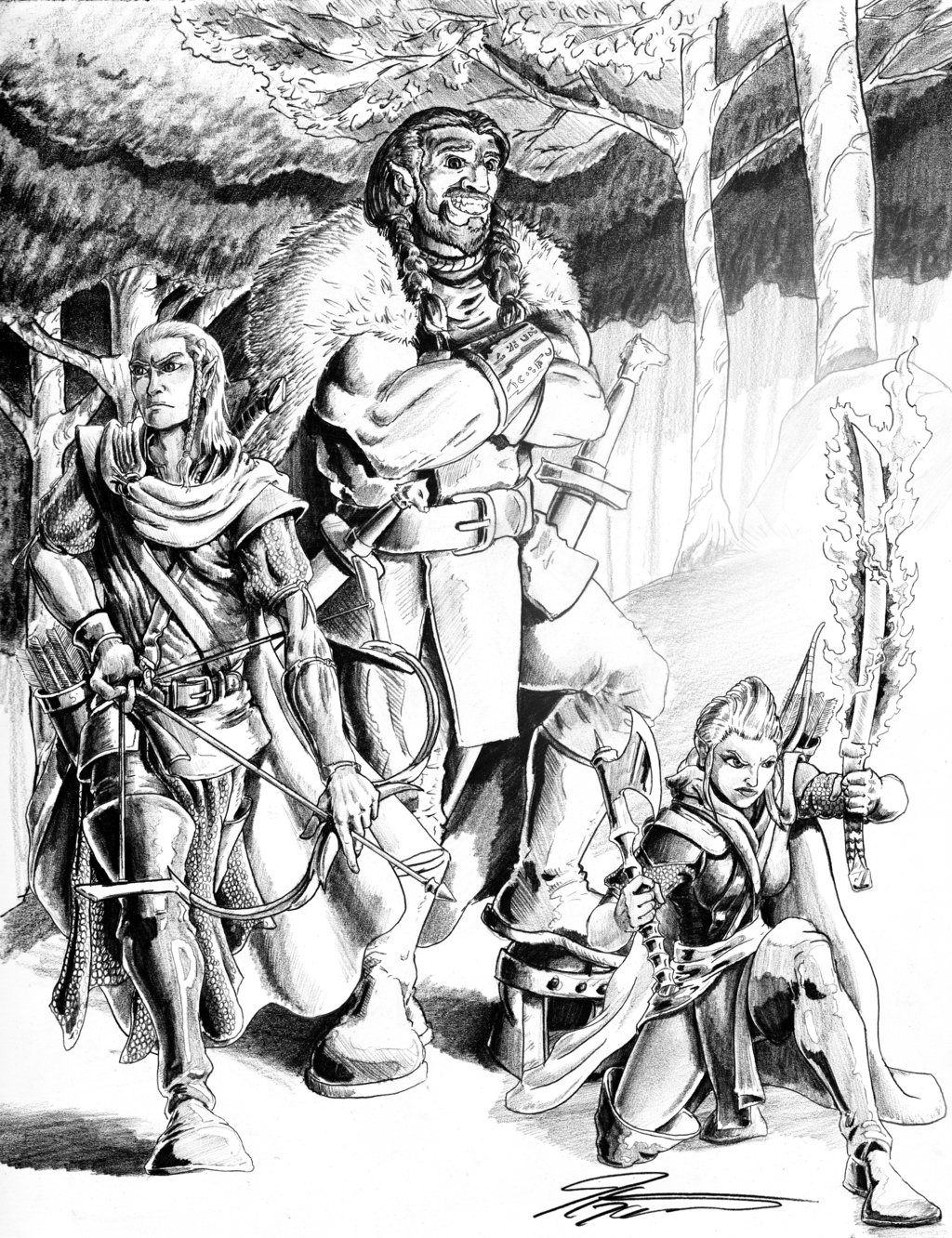Old-School Magic from Illustrator Joseph Garcia

Joseph Garcia’s “Lunchtime Sketch” of Darren Dare’s D&D priest/warrior “Sir Din Nilmornie.” Used with artist’s permission.
One of my favorite iconic books from D&D’s early days is the AD&D Rogues Gallery, and I don’t seem to be the only one nostalgic for it. Its long tables of essentially random character stats didn’t do much at the time to excite my imagination. However, the back half of the book featured a garrison of the game’s best-known characters: the first iconics, fully fleshed out and evocatively drawn.
A young DM at the time, I devoured the stats and descriptions for Mordenkainen, Robilar, Tenser, and many others, and appreciated that each profile noted which player (Gary Gygax, Ernie Gygax, Brian Blume, Jean Wells) had created it. The tight but thorough descriptions and role-playing notes accompanying each personality captured my imagination by showing me just how wide-ranging D&D characters could be, despite a common set of tools to play with.
But a significant part of the appeal was the art. Excellent black-and-white line-art depictions of the personalities, particularly those inked by Jeff Dee, ignited entire campaigns and stories in my head. My Dice Unloaded column is essentially a tribute to the Rogues Gallery, a feeble attempt on my part to rebottle the magic.
Lately, I’ve been getting that old Rogues kick out of a series of character portraits by Joseph Garcia, a self-taught artist out of Henderson, Nevada. Garcia’s “Lunchtime Sketch” feature on Facebook has lately, and regularly, gifted viewers with an old-school parade of new characters, each based on someone’s PC. Players tell him about their characters; Garcia weaves lines to embody them.
For instance, Garcia’s action-y depiction of Andrew Schwartz’s character, Duerval, makes me wonder why the hell I haven’t had more characters riding war rhinos. To be sure, it’s a cool idea to begin with, but Garcia’s adept hand raises the idea up to serious, Drizzt levels of Holy-Hell-I-Want-One-Too.

Jospeh Garcia’s “Duerval Approaches” depicts Andrew Schwartz’s character Duerval atop his war rhino. Used with artist’s permission.
The rhino’s horn is just the tip of an iceberg of cool, even among the subcategory of sketches involving animal companions. For instance, how many rangers choose a giant toad for a companion? I’m guessing more players will want a toad of their own after viewing Garcia’s depiction of Tim Gibbons’ ranger/wild-mage named Rael Swiftwing, who’s breathing fire beside his imposing and clearly unimpressed amphibian partner. Makes a pit bull look like a bonbon.
The characters without animal companions are similarly evocative. I’m not particularly enthralled by Westerns, nor by dwarves. But then I see this guy…

Joseph Garcia’s “Lunchtime Sketch” of Jesper Andersen’s Pathfinder Dwarven hunter, “Grimmnirr Wyrmcrest.” Used with artist’s permission.
… and now I want to play a Western-style, six-shootin’ dwarf prospector. With a war rhino. Because stay away from my gold.
And that’s a pretty reliable sign of a good artist, isn’t it?
You see what he or she has drawn, and immediately want to appropriate it, to do something with it, to integrate it into your life or the lives of your characters. I’m also charmed by these players, who clearly have some great ideas. It’s a nifty synergy. But it all falls apart if the artist isn’t up to the task, if he or she isn’t highly versatile. Lots of people can do boots and swords, only to fumble — natural 1 — on a rhino or toad. (Full disclosure: I can’t even do boots.)
Garcia takes ideas that were awesome in someone’s mind and makes them awesome for others. He admits it isn’t always easy.
“For the last few years, I’ve been offering free 40-minute sketches as a way to practice and enhance my speed and creativity. The resulting requests have pushed me further than anything else I’ve done,” he tells us.
“I have always been heavily influenced by comic book and animation visual styles, emulating the techniques of those wonderful artists,” he says. “While I was a late bloomer for tabletop gaming, high fantasy has always been a genre I’ve enjoyed. The majority of my favorite books, movies, and games were of the fantasy variety. It’s a genre where any character, regardless of their social standing, can achieve greatness with only the power of their will. In other media such as superhero comics and sci-fi, extraordinary characters will often follow their fate and do amazing things. However, in fantasy it seems that ordinary characters will defy their fates and do extraordinary things. That idea has always resonated with me.”
The greatest challenge to his artistic pursuits, he remarks, is finding time. Juggling career, family, and craft “is a daily struggle,” Garcia says. “Who needs to sleep, right?”
Of the pieces he’s completed to date, Garcia says he’s particularly proud of “Duerval Approaches” and the war rhino: “[Andrew Schwartz] initially asked for a sketch, but was so happy with it, he commissioned me for a full piece. His description was so full of life that I really wanted to capture the sense of movement and joy that he described. It was the largest character piece that I’ve done to date and I’m very happy with the result.”
(If you’re digging Garcia’s sketches as much as we do, you might also check out his works “Cleric of the Raven Queen” and “What? Oh No, I Found Them Like This,” both of which can be found on his DeviantArt site, under the name KingCorvid, along with more stuff and regular new postings.)
Like many creatives, Garcia has his own ideas that he hopes to pursue some day: original stories and characters. “But for now, I am honored to help others bring their characters and stories to life. It has been such a sincere joy to get to know these characters, and I am always thankful that people want to share them with me.”
♦ Graham Robert Scott writes regularly for Ludus Ludorum when not teaching or writing scholarly stuff. Like the Ludus on Facebook to get a heads-up when we publish new content.














